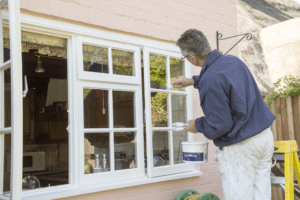As we all know energy inefficiency is a huge problem for most homes. Home improvement and performance are never-ending drills. Initiating the process of home energy can be quite overwhelming. Here’s a beginner’s list to get you going on the right track. Rated from 1 to 5 by level of difficulty to repair by: doing it yourself, cost, time invested and probable positive impact.
Replace Old Weather Stripping on Windows & Doors
Make sure to thoroughly search around all windows and doors. Be sure that the threshold seals snugly with the door. Weather stripping is available at any hardware store, is not costly, and installation is practical. You will need a pair of box scissors to cut to the desire length, peel off the support to show the sticky side, then stick it to the surface.
Pro Tip: It’s important to check your weather stripping once a year. Weather Stripping is great for avoiding heat loss, but is also prone to wear and tear. If it’s closing a door or window that gets a lot of use, you might need to replace it every so often.
Add Insulation to your walls and attic
Proper insulation can dramatically reduce the amount of energy your house uses. If you have a new house either fiberglass or cellulose insulates your walls and attic. Both are superb at doing their job – trapping heat – and lasts a lifetime. When checking your attic you may find that the fiber spray is a little thin or the fiberglass has settled, then it’s time to add some more. Spend some time conducting research and take a look at both options for price and ease of installation. Once you’re set you can go ahead and choose the right one for you. You can also add extra fiber on top of a layer of fiberglass or vice versa.
Pro Tip: When replacing the insulation yourself be sure to wear a gas mask with a vapor filter. You shouldn’t be breathing either type of insulation for a long time and also wear coveralls and safety glasses.
Replace old appliances
When it comes to using up energy, old-fashioned appliances are a burden. The most common are usually your hot water heater, your refrigerator, your washer/dryer, and your pool pump. Replacing all of the appliances that are eating up your home’s energy all at once is a huge hit to your wallet. First check how much energy you are wasting by using a calculator from the U.S. Department of Energy. Once you have a preset “energy budget” then you can then deliberate which appliances need to be changed or replaced. When looking around for replacements, look for the Energy Star label that tells you the appliances that meets the criteria of energy efficiency.
Pro Tip: Having energy efficient appliances that meet the Energy Star criteria can earn you rebates in the form of tax credits.
Replace your windows
The Department of Energy estimates that windows that let out too much heat can account for 10% to 20% of your heating or cooling bill.
Pro Tip: Installing energy efficient windows in your home can be an investment as well as it’s a great way to increase the overall worth of your home as well as curb appeal.
Invest in a smart thermostat
A smart thermostat is a brilliant starting point to keenly manage the heating and cooling of your home. A benefit of installing a smart thermostat is its capability to learn your habits. By knowing when you are most active at home, a smart thermostat can modify the temperature based on those habits. It’s great for staying comfortable, but also to save energy as well.
Pro Tip: The popular NEST thermostat has a lot of additions intended to save owners money on their electricity.
Source: Inspire Energy







